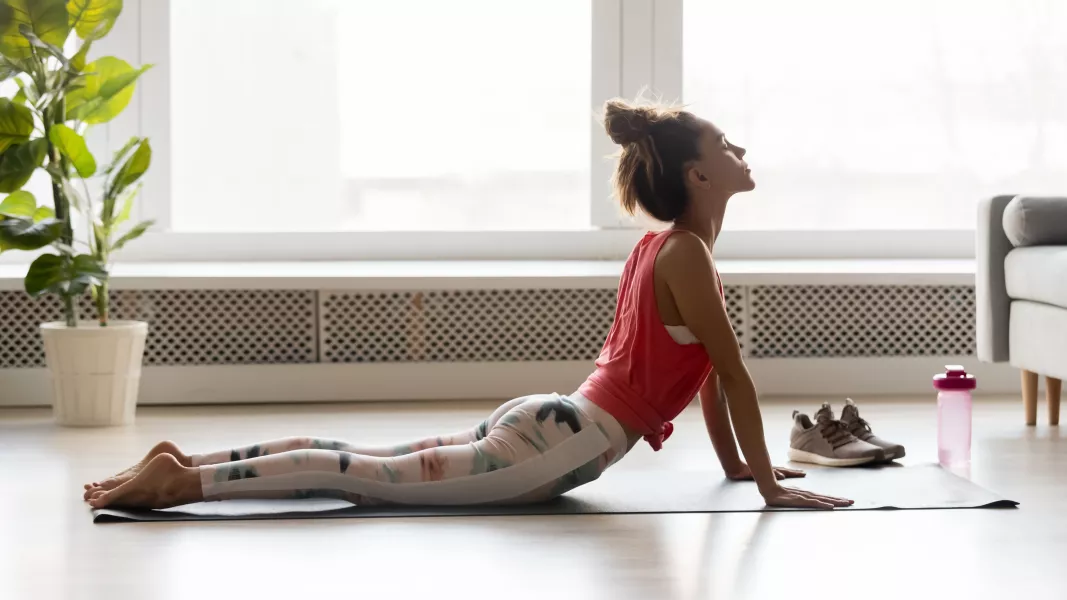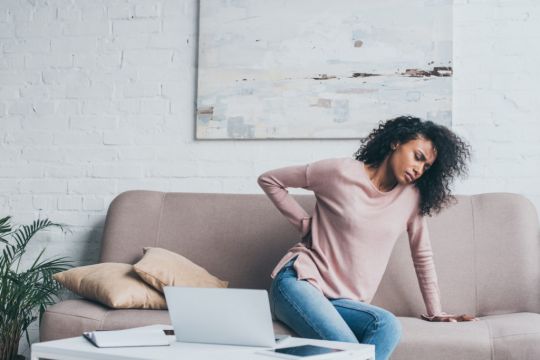There are lots of benefits to working from home – like wearing sweatpants all day, avoiding commuting delays, setting your alarm a little later. The downside is your back might suffer.
The Institute of Employment Studies, which polled 500 people earlier this year, found 55% of respondents said they’d experienced new aches and pains in their back since switching to work from home.
Back pain is extremely common, and although rarely serious, it can be very frustrating and troublesome (if your back pain is severe, doesn’t improve or accompanied by other worrying symptoms such as numbness or swelling, always get it checked by a doctor or physio).
View this post on Instagram
Advertisement
Generally speaking though, sitting in an unsuitable chair and hunching over a laptop for extended periods can easily cause back pain to flare up if you’re not careful – so what do we need to know?
Why does back pain happen?
“Lower back pain is the most common muscle or joint pain in the body, affecting millions of people throughout the world,” says Tim Allardyce, consultant physiotherapist and osteopath (surreyphysio.co.uk).
“It’s thought that one in every two adults will suffer some form of lower back pain in their life. Many people suffer with chronic lower back pain and there are lots of causes, including disc herniations (aka ‘slipped discs’), facet joint inflammation, structural issues with the vertebrae, and muscle pain.

“Degenerative stress on the joints, or repetitive over-use of the lower back can cause pain, as can repeated poor posture or spinal position over an extended period of time,” he adds.
Why might back pain be more common while working from home this year?
It’s not just your screen set-up playing a part here. Allardyce says there’s a number of reasons why you might be feeling more aches and pains right now.
“People are typically more sedentary at home. For example, you might usually walk to the station, get a train, then walk to the office,” he explains. “At lunchtime, you might walk to the local sandwich shop, and then when going home in the evening, you might walk back to the station. When you compare this to working from home, one thing becomes clear: you’re less likely to [be getting so much] exercise.”
Many people don’t realise that a lack of movement throughout the day can lead to back stiffness and muscle aching. A good way to keep an eye on this is to be mindful of your daily step count (you could keep track on your phone or with a fitness watch). As a benchmark, experts say 10,000 steps per day is a reasonable target for healthy, mobile adults.
“Another reason is poor workstation set-up. I’ve seen dozens of patients who report using laptops for long periods, or report sitting at their kitchen table, without a good seat, and with laptops too low or screens too low,” says Allardyce. “Adopting poor spinal positions for long periods can lead to pain and poor adaptations of the muscles.”
How can we relieve mild lower back pain at home?
If you’re experiencing mild back pain (and you’re otherwise generally fit and well), it might seem counterintuitive to exercise – but regular gentle movement can help to ease up the area.
“Walk to the shops and soak in some sunlight when the sun is shining,” advises Allardyce. “If you are unable to leave the house as you are shielding, and you have the budget, order an exercise bike and get cycling indoors instead.

“I’ve been doing daily press-ups through lockdown to help keep my back and core strong, as well as going for long walks with my family. Gyms are currently closed in lots of areas, but remember that you are allowed to exercise outside,” he adds.
Stretches can also help reduce mild lower back pain too (although always seek professional advice before starting a new exercise regime is you are experiencing serious ongoing symptoms, or have a history of more complex back pain issues). Pilates instructor Hollie Grant (pilatespt.co.uk) suggests trying a postural chain stretch.
“This stretch helps loosen off the muscles in the back of the body, and is ideal for those who are tight through the back of their neck from looking at their screens,” she says.
“Start standing with feet hip distance apart, with soft knees. Roll down from the crown of your head, one vertebra at a time, until your hands are as close to the ground as possible without bending your knees further.
“Once here, interlace your fingers and put your hands on the back of the head. Straighten your legs, and use the weight of your arms to gently pull your head towards your knees. You should feel an intense stretch up the back of the body, particularly where you are tightest.”
View this post on Instagram
Allardyce adds that squats, lunges, bridges and Swiss ball exercises are all good for strengthening the spinal area.
When should you worry that your back pain requires medical attention?
While back pain is very rarely dangerous, there are some signs that there may be something more serious going on – like nerve compression or damage. If you have a history of previous serious problems, it’s a good idea to keep an eye on any new symptoms and get things checked if you are concerned.
“If you start to feel numbness around the saddle area (the groin, buttocks and genitals), a loss of control of your bladder or bowel, or loss of sexual function associated with back pain, then you should seek urgent medical assistance, or go to A&E,” says Allardyce.
This can indicate rare but serious complications sometimes associated with disc damage and nerve compression. However, Allardyce reassures: “Most back pain is low grade grumbling, which many of us will encounter at some time or another.”
But if it’s troubling you? “Physiotherapy and osteopathy clinics are open, and the guidance rules say you are allowed to leave your house for medical appointments – so I’d recommend you speak to a local physio or osteopath for some hands-on treatment, advice and guidance to reduce your pain,” he adds.







